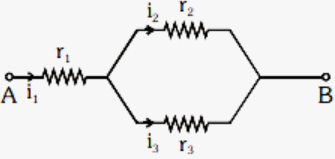Three resistors having resistances r1, r2 and r3 are connected as shown in the given circuit. The ratio i3/i1 of currents in terms of resistances used in the circuit is – (a). r2/ r1 + r3 (b). r1/ r2 + r3 (c). r2/ r2 + r3 (d). r1/ r1 + r2
By BYJU'S Exam Prep
Updated on: September 13th, 2023
The given figure is

As the resistances r2 and r3 are of parallel combination, the potential difference will be the same across both the resistances.
i2r2 = i3r3
i2 = i3r3/r2 ….. (1)
Similarly
i1 = i2 + i3
i1 = (r3/r2 + 1) i3 [From the equation (1)]
So we get
i3/i1 = r2/ r2 + r3
Therefore, the ratio i3/i1 of currents in terms of resistances used in the circuit is i3/i1 = r2/ r2 + r3
Summary:
Three resistors having resistances r1, r2 and r3 are connected as shown in the given circuit. The ratio i3/i1 of currents in terms of resistances used in the circuit is – (a). r2/ r1 + r3 (b). r1/ r2 + r3 (c). r2/ r2 + r3 (d). r1/ r1 + r2
Three resistors having resistances r1, r2 and r3 are connected as shown in the given circuit. The ratio i3/i1 of currents in terms of resistances used in the circuit is i3/i1 = r2/ r2 + r3
Related Questions:-
- Why Is The Amount Of Gas Collected In One Of The Test Tubes In Activity 1 Point 7 Double Of The Amount Collected In The Other?
- When An Object Is Plced At A Distance Of 50cm From A Concave Sperical Mirror The Magnification Produced Is 1by2 Where Should The Object Be Placed To Get A Magnification Of Minus 1by5?
- How To Conserve Forest?


